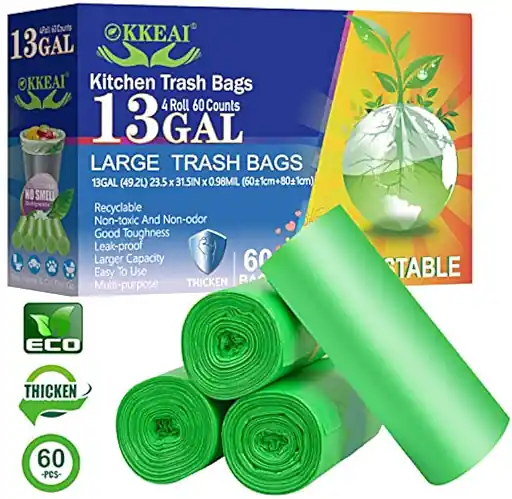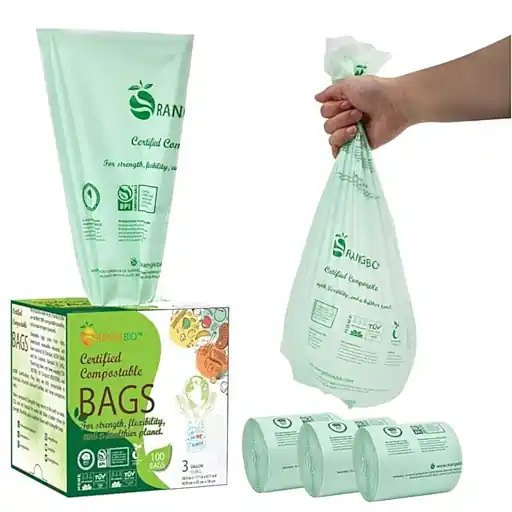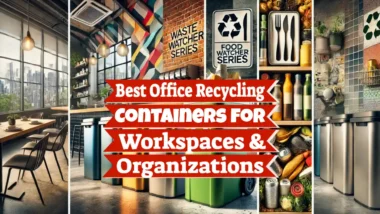In today's world, waste management is no longer just about disposing of trash. It's about finding sustainable ways to minimize our environmental footprint. One significant innovation in this field is the development of biodegradable trash bags, which offer a promising solution for achieving carbon-neutral waste management.
What You Will Learn:
- Biodegradable trash bags are made from renewable resources like cornstarch and vegetable oils.
- They decompose much faster than traditional plastic bags, taking months instead of centuries.
- Using biodegradable bags can significantly reduce carbon emissions and fossil fuel dependency.
- Understanding the difference between biodegradable and compostable bags is crucial for effective waste management.
- Consumers can play a vital role in promoting sustainable waste management by choosing biodegradable options.
The Impact and Need for Change
Our planet faces a mounting crisis due to the excessive use of traditional plastic trash bags. These bags, typically made from petroleum-based materials, take hundreds of years to decompose, causing long-term environmental damage. As they slowly break down, they release harmful microplastics into ecosystems, contaminating soil and waterways.

“Trash Can Liners? Small Garbage Bags …” from www.amazon.com and used with no modifications.
Environmental Challenges of Traditional Trash Bags
Traditional trash bags are a significant contributor to pollution. They are not biodegradable, meaning they remain in landfills for centuries. As they degrade, they leach toxic chemicals into the environment. This not only harms wildlife but also poses a risk to human health. The production of these bags also involves significant carbon emissions, contributing to global warming.
The Rising Demand for Sustainable Alternatives
With growing awareness of environmental issues, the demand for sustainable waste management solutions has surged. Consumers and businesses alike are seeking alternatives that align with eco-friendly practices. Biodegradable trash bags have emerged as a viable solution, offering an effective way to reduce plastic waste and its associated carbon footprint.
Understanding Biodegradable Trash Bags
Biodegradable trash bags are designed to break down naturally in the environment. Unlike their plastic counterparts, these bags decompose into non-toxic components, leaving no harmful residues behind. They are crafted from materials that microbes can easily digest, turning waste into compost over time.
What Makes a Trash Bag Biodegradable
For a trash bag to be considered biodegradable, it must be made from materials that can be broken down by microorganisms. Common materials used include cornstarch, vegetable oils, and other plant-based substances. These materials decompose through natural processes, significantly reducing the environmental impact.
Biodegradable trash bags are not only environmentally friendly but also practical for everyday use. They are designed to be strong and durable, capable of handling typical household waste without tearing or leaking. For those interested in sustainable living, a zero waste kit can complement the use of biodegradable bags by further reducing household waste.
Biodegradable vs. Compostable: What's the Difference?
It's essential to understand the distinction between biodegradable and compostable bags. While both are eco-friendly options, they have different decomposition processes. Biodegradable bags break down naturally over time, but the speed and completeness of decomposition can vary based on environmental conditions.
Compostable bags, on the other hand, are specifically designed to break down in a composting environment, turning into nutrient-rich compost. They require specific conditions, such as high temperatures and humidity, to decompose effectively.
Innovations in Material Composition
Recent advancements in materials science have led to the development of more effective biodegradable trash bags. These innovations focus on enhancing the strength, durability, and decomposition rate of the bags, making them a practical choice for everyday use.
Plant-Based Materials: Corn, Sugarcane, and More
Biodegradable trash bags are often made from plant-based materials such as corn, sugarcane, and potato starch. These renewable resources are not only sustainable but also help reduce our reliance on fossil fuels. By using plant-based materials, we can create a closed-loop system where waste is transformed back into valuable resources.
For instance, cornstarch-based bags are a popular choice due to their ability to decompose quickly and completely. These bags are designed to handle both wet and dry waste, making them versatile for various waste management needs.
Biopolymers and Their Role in Biodegradability
Biopolymers are at the heart of biodegradable trash bags. These naturally occurring polymers are derived from living organisms and are designed to break down efficiently in the environment. Common examples include polylactic acid (PLA) and polyhydroxyalkanoates (PHA), which are used in a variety of biodegradable products.
PLA is derived from fermented plant starch, such as corn or sugarcane, and is known for its strength and durability. It is often used in combination with other biopolymers to enhance the performance of biodegradable bags. PHA, on the other hand, is produced by bacteria and is fully biodegradable, breaking down into water and carbon dioxide under the right conditions.
These biopolymers not only contribute to the biodegradability of trash bags but also reduce reliance on traditional plastics, making them a crucial component in the transition to more sustainable waste management practices. To explore how these innovations fit into broader environmental efforts, learn about the harmful effects of plastic on our environment.
Contribution to Carbon-Neutrality
Biodegradable trash bags play a significant role in achieving carbon-neutral waste management. By replacing conventional plastic bags with biodegradable alternatives, we can significantly reduce carbon emissions and the environmental impact of waste disposal.
Reducing Fossil Fuel Dependency
The production of traditional plastic bags relies heavily on fossil fuels, contributing to greenhouse gas emissions and environmental degradation. In contrast, biodegradable bags are made from renewable resources, which drastically cuts down the carbon footprint associated with their production.
Moreover, the use of plant-based materials in biodegradable bags helps sequester carbon during their growth phase, offsetting some of the emissions generated during manufacturing. This shift from fossil fuel dependency to renewable resources is a critical step towards achieving carbon neutrality.
Lifecycle Analysis: From Production to Decomposition
To fully understand the environmental benefits of biodegradable trash bags, it's essential to consider their entire lifecycle. This includes the sourcing of raw materials, manufacturing processes, usage, and eventual decomposition.
During production, biodegradable bags typically generate fewer carbon emissions compared to traditional plastic bags. This is primarily due to the use of renewable resources and more efficient manufacturing techniques.
Once used, biodegradable bags are designed to decompose quickly in the right environmental conditions. This reduces the amount of waste that ends up in landfills and minimizes the release of harmful pollutants into the environment.
Ultimately, the lifecycle analysis of biodegradable trash bags highlights their potential to reduce environmental impact and contribute to a more sustainable future. For a deeper understanding, explore how these innovations are revolutionizing waste management.
Challenges and Considerations
While biodegradable trash bags offer numerous environmental benefits, there are still challenges and considerations to address. These include issues related to production, market acceptance, and public understanding of biodegradable products.
One major challenge is ensuring that biodegradable bags decompose effectively in real-world conditions. Factors such as temperature, humidity, and microbial activity can all influence the decomposition process, making it essential to educate consumers on proper disposal methods.

“THFBKMV OKKEAI Biodegradable Trash Bags …” from www.kmart.com and used with no modifications.
Challenges in Mass Production and Market Penetration
The mass production of biodegradable trash bags requires significant investment in new technologies and manufacturing processes. While demand for these products is increasing, the cost of production remains higher than that of traditional plastic bags. This can make it challenging for biodegradable bags to compete in the market.
Additionally, widespread adoption of biodegradable bags requires collaboration between manufacturers, retailers, and consumers. Educating the public about the benefits and proper use of these bags is crucial for driving demand and ensuring their successful integration into everyday waste management practices.
Sorting Fact from Fiction: Common Misconceptions
There are several misconceptions about biodegradable trash bags that can hinder their adoption. For example, some people believe that these bags can decompose in any environment, but this is not always the case. Biodegradable bags often require specific conditions, such as industrial composting facilities, to break down effectively.
Another common misconception is that biodegradable bags are less durable than traditional plastic bags. However, advancements in materials science have improved the strength and reliability of biodegradable options, making them suitable for a wide range of waste management needs.
Future of Waste Management
The future of waste management lies in embracing sustainable practices and innovative solutions like biodegradable trash bags. As technology continues to advance, we can expect even more efficient and environmentally friendly waste management options to emerge.
By choosing biodegradable products and supporting companies that prioritize sustainability, consumers can play a vital role in driving positive change and promoting a cleaner, greener future for our planet.
Potential for Biodegradable Bags in a Circular Economy
Biodegradable trash bags hold great potential within a circular economy framework. In a circular economy, products and materials are designed to be reused, repaired, and recycled, minimizing waste and conserving resources. Biodegradable bags fit seamlessly into this model by providing an eco-friendly alternative to traditional plastic bags, which are difficult to recycle and often end up in landfills.
The use of biodegradable materials can help close the loop in waste management. These bags decompose into natural elements, enriching the soil and reducing the need for chemical fertilizers. This process not only helps mitigate the environmental impact of waste but also contributes to a healthier ecosystem.

“OrangeBio 100% Compostable Trash Bags …” from www.ebay.com and used with no modifications.
Furthermore, the adoption of biodegradable bags can drive innovation in other sectors. As demand for sustainable products grows, companies are encouraged to develop new materials and technologies that align with circular economy principles. This can lead to more efficient production processes, reduced resource consumption, and ultimately, a more sustainable future.
- Biodegradable bags decompose into natural elements, reducing landfill waste.
- They contribute to soil enrichment, promoting healthier ecosystems.
- Increased demand for biodegradable products encourages innovation in sustainable materials.
- Biodegradable bags support the principles of a circular economy by minimizing waste and conserving resources.
How Consumers Can Participate in Change
Consumers play a crucial role in driving the adoption of biodegradable trash bags and promoting sustainable waste management practices. By making informed choices and supporting eco-friendly products, individuals can help create a demand for more sustainable solutions.
One simple way to participate is by choosing biodegradable trash bags for household waste. This small change can have a significant impact on reducing plastic pollution and supporting the development of sustainable waste management systems. Additionally, consumers can advocate for biodegradable options in their communities, encouraging local businesses and organizations to make the switch.
Frequently Asked Questions (FAQ)
Understanding the benefits and limitations of biodegradable trash bags is essential for making informed decisions. Here are some common questions and answers to help clarify any confusion.
By addressing these FAQs, we aim to provide clear and concise information to help consumers make informed choices about biodegradable trash bags.
Let's explore some of the most frequently asked questions regarding biodegradable trash bags and their impact on the environment.
How long does it take for biodegradable trash bags to decompose?
Biodegradable trash bags can decompose within a few months to a couple of years, depending on environmental conditions. Factors such as temperature, humidity, and microbial activity play a significant role in the decomposition process. In optimal conditions, such as industrial composting facilities, these bags can break down much faster than in a landfill.
Are biodegradable trash bags stronger than regular plastic bags?
Biodegradable trash bags have come a long way in terms of strength and durability. Thanks to advancements in materials science, these bags are now designed to withstand typical household waste without tearing or leaking. While they may not be as strong as some heavy-duty plastic bags, they are suitable for most everyday waste disposal needs.
It's important to note that the strength of biodegradable bags can vary depending on the materials used and the manufacturing process. Consumers should look for reputable brands that prioritize quality and durability.
“Modern biodegradable trash bags are engineered to be as strong and reliable as traditional plastic bags, making them a practical choice for sustainable waste management.”
Can I use biodegradable bags for all types of waste?
Biodegradable trash bags are suitable for most types of household waste, including food scraps, paper, and garden waste. However, they may not be ideal for heavy or sharp objects that could puncture the bag. It's essential to use these bags as intended and avoid overloading them to prevent tearing.
For specific waste types, such as hazardous materials or medical waste, it's crucial to follow local regulations and guidelines for proper disposal. Biodegradable bags are not designed to handle these types of waste and may not provide the necessary protection.

“BioBag 96 Gallon Compostable Trash Bags …” from www.goodstartpackaging.com and used with no modifications.
What should I look for when buying biodegradable trash bags?
When purchasing biodegradable trash bags, consider the following factors to ensure you choose a high-quality product:
- Material Composition: Look for bags made from renewable resources like cornstarch or PLA.
- Certification: Check for certifications from reputable organizations, such as the Biodegradable Products Institute (BPI), to ensure the bags meet industry standards.
- Strength and Durability: Read reviews and product descriptions to determine the bag's strength and suitability for your needs.
- Decomposition Rate: Consider how quickly the bags will decompose in your local waste management system.
By considering these factors, you can make an informed decision and support sustainable waste management practices.
Do biodegradable bags really help in reducing carbon emissions?
Yes, biodegradable bags can significantly reduce carbon emissions compared to traditional plastic bags. The production of biodegradable bags typically generates fewer emissions due to the use of renewable resources and more efficient manufacturing processes. Additionally, the decomposition of these bags results in fewer greenhouse gases being released into the atmosphere, unlike the harmful effects of plastic which contribute significantly to environmental pollution.
By choosing biodegradable options, consumers can contribute to a reduction in carbon emissions and support the transition to a more sustainable waste management system. This shift not only benefits the environment but also promotes a healthier and more sustainable future for all.







